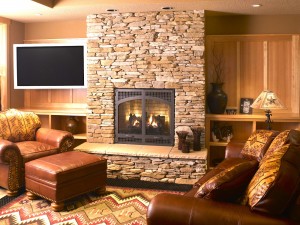We are planning to remodel our older home, and I’ve read that increasing thermal mass can improve energy efficiency. What exactly does this mean, and how do we incorporate it into our home?

Increasing the thermal mass means increasing the ability of materials to retain heat energy. This can be done anytime, but it is ideal when remodeling. Increasing the thermal mass does not require a “Fred Flintstonesque” decor with a pile of rocks in the center of every room. Actually, most of these improvements are quite attractive.
The concept of increasing thermal mass means having the house structure and interior objects absorb and hold as much heat energy as possible. The heavier the items in your home, the more mass it has to better absorb heat. As the outdoor temperature changes, thermal mass helps moderate indoor temperature swings to improve comfort and efficiency. It is comparable to the way a heavy, high “physical” mass automobile provides a smoother ride by absorbing the energy from bumps.
Old-fashioned solid log and heavy timber-framed houses used this thermal mass concept. Even though a log house has a small amount of actual insulation R-value when compared to a typical framed house, its utility bills are often not significantly higher, particularly during the summer.
There are several ways thermal mass can save energy in your home. By reducing the indoor temperature swings during winter months, less heat is lost through the walls and windows. This is particularly true in rooms where heat is generated, such as the kitchen or bathroom, or rooms with large south-facing windows. During summer months, the mass will help keep rooms cooler and delay the use of air conditioning.
In winter months, during the day, heat produced by the HVAC system is absorbed by the home’s thermal mass. At night, heat is released to warm the home. The greater the mass, the more it will keep the home comfortable.
During the summer, high thermal mass delays the need for the air conditioner to kick on in the morning and throughout the daytime. Unless high humidity is an issue, opening windows at night and running a whole-house or window fan allows the thermal mass to lose the heat stored from the daytime. Close the windows in the morning and the cooled thermal mass absorbs heat coming in without causing the room temperature to rise as fast. The thermal mass of air is extremely low, so the cold outdoor air quickly absorbs heat from the indoor thermal mass.
Increase the thermal mass in your house by selecting proper high mass, or heavier, materials. They should be located throughout the home, but concentrate on rooms that generate heat or tend to overheat during the summer. When building a house or adding rooms, use heavy foam insulating sheathing on the outside of the wall framing. This allows the framing lumber to become part of the interior thermal mass.
The thermal mass of various materials is rated by heat capacity properties. Water has a high relative heat capacity of 62.4 per cubic foot compared to drywall at only 1.3 per cubic foot. Wet soil rates about 55, concrete is about 31, brick is about 27, and stone/tile ranges from 18 to 36 depending upon type. Their natural thermal properties, in addition to their densities, determine the above relative numbers.
Installing a dark, ceramic-tile flooring near a door or window is an excellent source of thermal mass. Decorative walls using solid bricks work well in a room with a fireplace or large windows. Heavy granite or slate countertops in a kitchen are effective. Wooden floors can also be a good source for thermal mass. Remember, the idea is to replace lighter materials with heavier materials.
The damp soil in large potted plants can store much heat, and the plants naturally purify the indoor air. Storing jugs of water you keep for emergencies under cabinets and near your heating system will also increase thermal mass.
James Dulley is a nationally syndicated engineering consultant based in Cincinnati. If you have a question about energy use or energy-efficient products, send it to: James Dulley, Electric Consumer, 6906 Royalgreen Drive, Cincinnati, OH 45244; or visit www.dulley.com.



